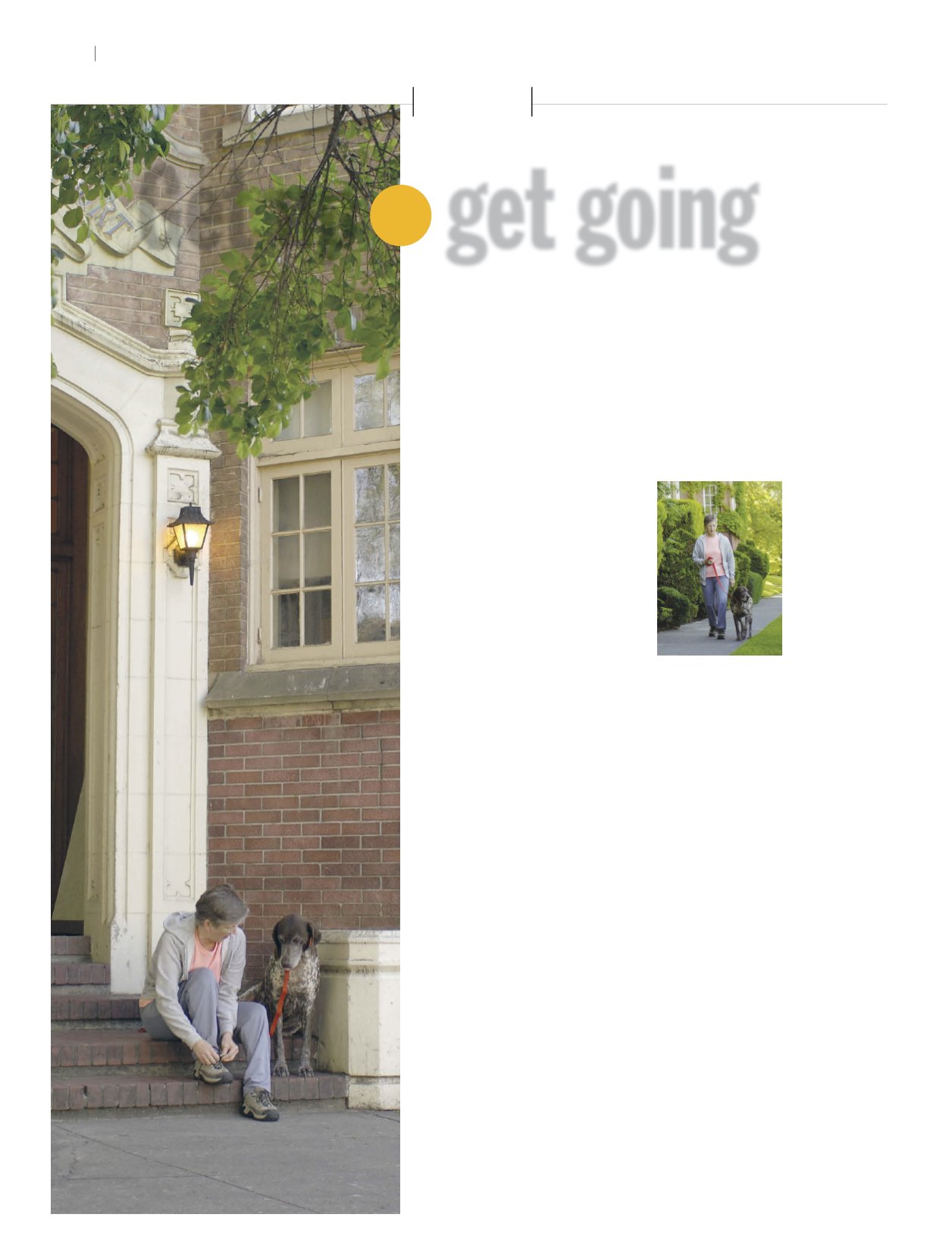
Staying active is one of the healthiest things we
can do as we age. For more exercise tips, go to
BOOST YOUR BODY AND YOUR HEALTH BY
TAKING AN ACTIVE APPROACH TO AGING
Get up
get going
and
L L
You won’t find it bottled and sold on one of those TV infomercials peddling the
latest anti-aging remedy. Exercise—one of the true keys to aging well—is yours
for the taking.
✦
No matter how old you are—whether you’re inching closer to
retirement or already knee-deep in grandkids and your golden years—exercise
is a good deal. What’s more, you don’t need to build bulging muscles or break
a sweat in the gym. On the contrary, one of the great things about exercise is
that you can benefit from low-impact activities
that take a modest amount of effort, such as
walking.
GREAT REASONS TO DO IT
What’s to be gained
by becoming a regular at exercise? Plenty. You can
improve your health and help counter some of the
effects of aging. For one, as we get older, we lose
muscle mass and strength—a process that can
speed up if we’re not moving. Think “use it or lose
it.” Likewise, physical activity can help you stay
strong so you can do more activities and remain
independent as you age.
According to the National Institute on Aging
and other health authorities, physical activity also
can prevent or delay serious health conditions,
including heart disease and high blood pressure,
as well as lift your spirits, boost your energy, and
help keep you flexible and steady on your feet.
MULTIPLE WAYS TO MOVE
Different types of ac-
tivities offer a range of health and fitness benefits.
According to the U.S. Department of Health and
Human Services, here are two types to focus on:
Aerobic exercises.
These are activities that
raise your breathing and heart rates; build en-
durance; and improve heart, lung and circula-
tory health.
Brisk walking is a great way to get aerobic ex-
ercise. For this do-anywhere workout, you only
need sturdy, well-fitting shoes. Cycling, swim-
ming, playing tennis and even gardening also can
provide an aerobic workout.
Strengthening activities.
These include work-
ing with weights or resistance bands or doing
pushups and other calisthenics to help your
muscles get stronger.
In addition, stretching exercises can help keep
your joints limber, and activities that improve
balance may reduce your risk of falls.
Moderate exercise is generally safe for most
people, including
healthy adults older
than 5. But if you
haven’t been active
for a while or have
any chronic health
problems, talk with
your doctor first to
find out what types
and amounts of ex-
ercise are safe and
appropriate for you.
HOW MUCH? HOW OFTEN?
There’s no such thing
as wasted motion—any amount of exercise is
better than none. So start slowly. Taking even
short walks at a light pace is a step in a healthy
direction.
But for significant health benefits, you should
gradually build up to at least 2½ hours (50 min-
utes) of moderate aerobic exercise each week.
You don’t need to do it all at once. You might
try short bouts—aim for at least 0 minutes at a
time—throughout the week.
If you’re already active and enjoy more chal-
lenging pursuits, such as jogging, another way
to meet the recommended weekly minimum is
to do hour and 5 minutes of vigorous activity.
In addition, experts recommend muscle-
strengthening activities on at least two days a week.
To benefit from exercise, you’ll need to keep it
up. These tips can help:
●
Choose activities you enjoy and that suit your
abilities.
●
Mix it up. Try walking one day and lifting
weights the next. Varying your routine also re-
duces your risk of injury.
●
Make it social. Exercise with family or friends
or join a class or walking group.
●
Schedule it. Make it a priority now, and soon
it will be part of your routine.
6
L A T E S P R I N G 2 0 1 4
T H E
S A M A R I T A N


